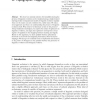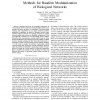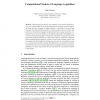39 search results - page 3 / 8 » Modular learning models in forecasting natural phenomena |
ALIFE
2006
13 years 5 months ago
2006
We show how cultural selection for learnability during the process of linguistic evolution can be visualized using a simple iterated learning model. Computational models of linguis...
ACL
2010
13 years 3 months ago
2010
We argue that groups of unannotated texts with overlapping and non-contradictory semantics represent a valuable source of information for learning semantic representations. A simp...
BIBE
2006
IEEE
13 years 11 months ago
2006
IEEE
— Biological networks are formalized summaries of our knowledge about interactions among biological system components, like genes, proteins, or metabolites. From their global top...
CICLING
2010
Springer
14 years 6 days ago
2010
Springer
Abstract. Child language acquisition, one of Nature’s most fascinating phenomena, is to a large extent still a puzzle. Experimental evidence seems to support the view that early ...
COLING
2000
13 years 6 months ago
2000
In the framework of statistical machine translation (SMT), correspondences between the words in the source and the target language are learned from bilingual corpora on the basis ...



